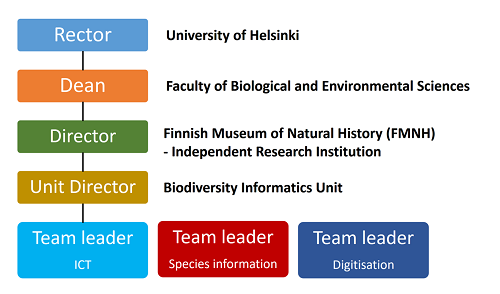FinBIF in a Nutshell
The Finnish Biodiversity Information Facility is a digital, Internet-based service infrastructure for data management. Biodiversity data available through the facility is primarily compiled from partner organisations, research institutes of Finland’s environmental and natural resources administration, other government organisations managing and producing biodiversity data, collections maintained by museums of natural history, and citizen science sources. Data content provided by the sources is copied from the data systems of participating organisations via data transfer interfaces in a manner that is as real-time as possible.
At FinBIF, resources are particularly needed for maintaining the data system and coordinating processes for the flow of biodiversity data. In addition, resources are required for both domestic and international cooperation and partnership management. Development of FinBIF must be safeguarded by partner collaboration or separate organisational activities.
In addition to managing and sharing biodiversity data, FinBIF offers services for storing observations for public use through the facility.
Responsibility for managing the facility lies with the Finnish Museum of Natural History Luomus.
Principal duties of FinBIF
- Compiling species observation data and sharing the data for free use
- Promoting open data and science
- Maintaining the national taxonomic nomenclature
- Strengthening and clarifying the processes related to the flow of biodiversity data
- Data archiving
- Maintaining and updating the data policy related to national biodiversity data
- Promoting citizen science
- Annotating shared data to settle its reliability and quality
Collecting and sharing species observation data
FinBIF maintains a data warehouse where biodiversity data based on original observations is copied to from the databases of partner organisations. Primary observation details include species names, location data, observation time and observer names. In addition to observation data collected for various purposes, related metadata will be published. This may contain, among other things, information on observation methods and conditions. Metadata helps data users evaluate the viability of each dataset.
Biodiversity data in the national FinBIF data warehouse is available both in its original form and as refined lists, statistics, maps and diagrams. FinBIF is capable of managing sensitive biodiversity data. No data will be published that could threaten the preservation of wildlife. The quality of observation data is emphasised, and methods for ascertaining the accuracy of data are constantly being developed by FinBIF and its partner organisations. All verified errors will be corrected before sharing data and no unreliable information will be published.
FinBIF works in cooperation with the Global Biodiversity Information Facility (GBIF) and provides all observation data in its data warehouse for international use. FinBIF has the ability to act as a gateway to other networks distributing and using biodiversity data globally.
The organization of FinBIF
The Finnish Museum of Natural History, Luomus (FMNH) is responsible for maintaining the Finnish Biodiversity Information Facility together with its partners. The Finnish Museum of Natural History is part of the University of Helsinki.
In March 2024 an advisory steering group for FinBIF was formed. The group is led by the Finnish Prime Minister’s Office.

Documents
This section contains formal documents published by FinBIF.
Data policy sets the principles for compiling, maintaining and using all digital datasets managed by the Finnish Biodiversity Information Facility. Data policy was updated during fall 2019.
Presentations contains presentations about FinBIF in English.
Enterprise Architecture (Public Administration Architecture, operating model for leadership) exists in Finnish only.
CoreTrustSeal is an international certification for trustworthy data repositories. FinBIF’s CoreTrustSeal application is in the process of being reviewed (4/2024).